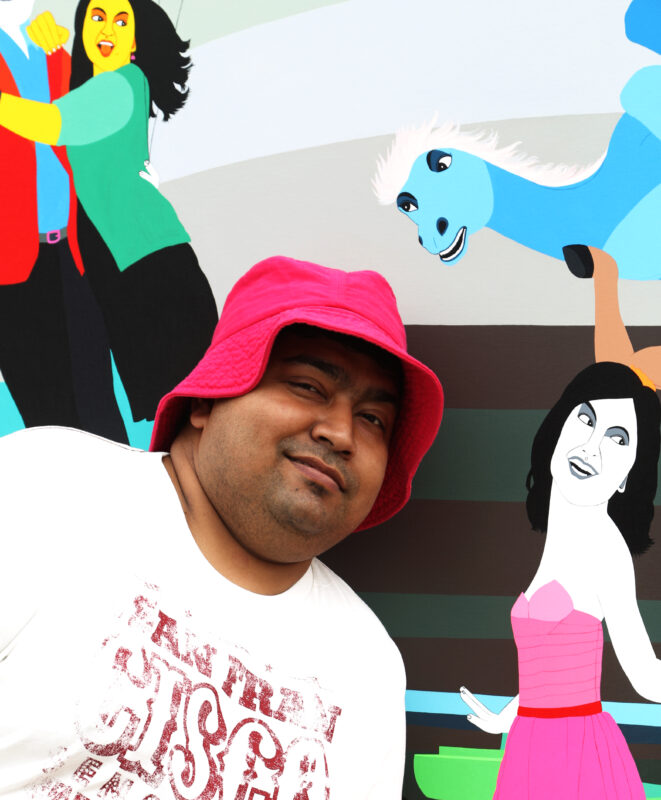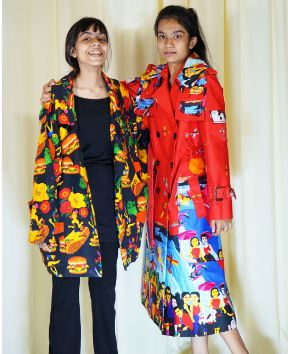In a cartoon show by veteran cartoonist Sudheer Nath in New Delhi long back, (Late) Sheila Dixit, the former CM of Delhi, stopped at her own. When this reporter asked how does she feel seeing cartooned as a bird? Before replying, she burst out laughing, and said, “It’s so much fun. I smile looking at myself. We (political leaders) should be ready for an artist’s scrutiny of us.”
That’s what a fun-work does to you. A person with a sense of humour makes many friends. So, even if he is poking fun at you, you would laugh it away while accepting it. India has lesser number of artists whose works of art have humour embedded in them. Veteran artists like Ramachandran, Amit Ambalal are among few one can count on fingers.
Ironically, while humour in art isn’t taken seriously, among the contemporary artists, Farhad Hussain has not only dared to express humour on his oil canvases which is quite upfront, never attempting to hide behind metaphors, but also filled the void created after his seniors stopped painting. This is a style that captured the attention of the art lovers, viewers, art gallerists and auctioneers alike. He has been the apple of art lovers and buyers’ eyes since 2005. His unique works drew attention of auction houses like Sothby’s, Christie’s, International art fairs in Singapore, Daegu and KIAF Art Fair in Korea, and many more.
Farhad, 47, paints people – just people; from the society that he lives in. Their behaviours, body language, aspirations, goals, hypocrisy and the façades that they keep exposing subtly, the superficiality that mark their lives routinely.

Notably, you will not find much about his personal life or artistic journey on the internet. Though a lot about his work and style can be found. Let’s know him from close quarters.
Making of an artist
Farhad is West Bengal’s child, living in New Delhi’s posh Jungpura.
An artist’s art is about his own making, the ingredients are from his life, both genetic and acquired. Farhad is no exception. His art is a mix of childhood days spent with his maternal grandma in Bengal, some 200 pets at huge ancestral home in Bengal – from birds, to hens to ducks, swans, cats and dogs. His home was “literally a chidiyakhana (zoo)”.
No wonder, lot of the fun element in his characters come from the playfulness of these animals and birds, his own maskharapan (jovial attitude) and a façade of happiness displayed by his characters in elitist, page three events. Farhad was “a naughty kid”. He would “run away from school to do fishing all day” and get home for a round-up by nani (maternal grandmother). He would love to paint and learn cooking from the traditional cook of his zamindar grandfather, Kalimuddin “on whose name Kalimuddin Lane still exists in Kolkata.”
A pampered kid, who was born with a silver spoon, is therefore, not the kind to be bowed down before an egoist. He dares to hold up a mirror to the ‘high-society’ he lives in. He draws their fault-lines and superficiality quite unapologetically. However, his dare is wrapped in hilarity.
Hence, even his lying Buddha is mischievously winking. His characters are people in elitist gatherings, a party or a family of billionaires. They look straight at you, laughing, smirking. They could be in a party ware — short dresses, ultramodern gears, some even in promiscuous poses. They dance, pose for a camera with a forced ‘say cheese smile’ or are busy taking selfies with friends or a pet, their elders are busy with other men and women. A happy pet is an integral part of such gatherings or a family, treated with elan. Most of his characters are in good health and shapes, away from the hustle–bustle of daily struggles to survive.
“I observe my characters from a distance in high-end parties. I don’t mix up with them, drink or dance. If I do so, I wouldn’t be able to discern and create.”
Colours are pals
Farhad is also a cook by passion. “I can cook ancient dishes, whose recipes are not available now. I also cook food which are a mix of global recipes,” he laughs explaining.
That’s what creativity is all about. The mixing of colourful spices notably reflect in the liberal doses of unusual blend of hues on his canvases.
For instance, his characters appear clearer against flat, single tone, bright shades like turmeric’s, or red chillies with distinctive textures. Every hue, dark pinks, reds, blues, greens, yellows, oranges and blacks find a royal space in Farhad’s oeuvre. Creativity they say it right, never occurs in a hollow.
His people on canvas wear unusually bright apparels. No wonder, this artist is also a fashion designer.
As the art market went down, Farhad transferred his spectacular designs on apparels, thanks to his textile and fashion designer wife Yasmin. The duo create exceptional dresses on which Farhad gets his art painted or embroidered. His attires come under wearable fashion, but for those who love bright tints and would wish to flaunt them.

Guru and technical journey
Farhad has been drawing since school days. He would imitate masters in his favourite water colour as a child. As a product of Santiniketan, he learnt to draw nature, as he would go fishing alone and avoid the company of large groups by which he felt distracted.
Soon, he “digested” the essence of Kalighat style of paintings defined in round, fat, innocent figures with “tana chokh” (beautiful, long slant eyes). His interest in Japanese Meiji style of painting with western influence and wooden blocks and further study at MS University, Vadodara helped him explore new dimensions in creating modern art.
All that started after his guru, veteran painter Shyamal Dutta Ray, asked him to “join a newspaper and do freehand work. Whatever you make, will be your own skill”. The prophetic words came true. The distinctive style that Farhad has adopted, is uncommon in the country. So much so that despite the ills of the high-end society he paints, ironically, it is them who buy his works, globally!
Make me for my wall
Interestingly, for several years, he had been commissioned to make families of billionaires in the same distinct style. “They themselves told me how they wanted to look like in my works,” laughs the painter, before adding, “they know I don’t mean any wrong but humour on their wall. I hide their pain behind their smiles. Why should I sell pain through my work? Pain should be gulped. Not shown.”
Does he know that some ‘serious’ artists give less weightage to his works?
“If a serious artist will ever ask me why I make funny works, I will ask him why you are so serious,” he says as his child-like laughter fills the air. The man with immense interest in astrology feels seriousness is a by-product of an urge to be seen in a particular category.
Away from the world
Farhad is unremorseful about not reading books anymore. “I used to read a lot of Tagore and Sharatchandra Chattopadhayay among others. Now I don’t. It distracts.”
Protest work? No
Farhad is unapologetic about not doing any protest paintings either.
“It doesn’t affect a limb of a person you are protesting about. To paint political, you should be having an aspiration to be in politics, straight or obliquely. Also, you should be in a powerful position to challenge or protest. I have neither. So, I am happy in what I am doing. I’ve got to protect my family. The day I wish to join politics, I shall be brazen enough to paint too.”
He “never paints to suit the market trends” either, nor he thinks art should be used as a medium for social change.
“No one takes any messages. Let’s stop fooling ourselves,” he sneers.
The silence of mind, not heart
The artist has seen both best and worst days in his artistic journey.
“There was a point in time when people would come to me with bagful of money to buy my art, or ask me to contribute my works for philanthropy. I used to be the guest of elites of the business and art world in Mumbai but soon it overpowered my nerves. I used to think, ‘ye sab kya hai?’”
And the thought seemingly led to a downfall. “I knew this was a part of life and I’ve got to live through it.”
After watching the “circus of the world, the pretentions, ill-intentions, egos of the gallerists” who exhibit his works and claim they can make or break his career, he now stays away from such “clowns in real life”.
For him, regular meditation, taking the best from all religions, and focussing on the target that he wishes to keep a secret of, is the driving force.
A father to two teenage daughters Malka and Yarina, Farhad is now busy reinventing himself with his designer wife. The results are showing. His apparel is creating a buzz in both fashion and the art world.
A contented believer Farhad stoically philosophises, “Everything is destined, you get what’s already penned for you by God. Hurrying it up spoils your own journey. When you start leaving, you start getting it. Meri dictionary main ‘ye hona hai’ wala cheez nahi hai, ‘mujhe ye karna hai wala’ cheez hai (In my lexicon, it is about what I have to do not what is to happen).”
Working hard towards a target, with spiritually elevated self — no drinking, no womanising, no partying around with the kind of characters he makes on his canvases — is the real Farhad Hussain for you.





